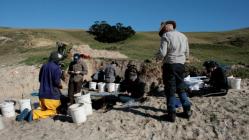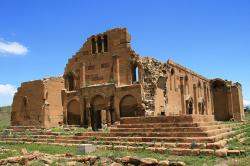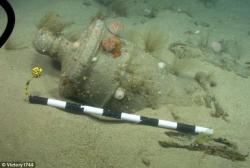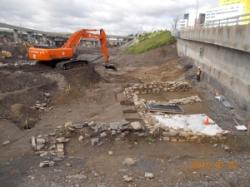INSTITUT SUPERIEUR D'ANTHROPOLOGIE
INSTITUTE OF ANTHROPOLOGY
ONLINE COURSES / COURS A DISTANCE
FALL TERM : OCTOBER 2015
REGISTER NOW
NOUVELLE ZELANDE –  Great Mercury Island - Moa-bone fishhooks and fossilised dog poos are amongst the treasures unearthed by archaelogists combing the remains of one of the oldest human settlements ever uncovered in New Zealand. But the researchers warn that rising sea levels and accelerating coastal erosion mean the sites will soon be lost forever. A team of researchers from the University of Auckland and Auckland Museum have found evidence of a small fishing settlement on Great Mercury Island - the private island owned by controversial richlisters Michael Fay and David Richwhite. The village, in Coralie Bay is thought to have been inhabited by Maori as early as 1350AD, just 30 years after some estimates of the first Polynesian landfall in Aotearoa. The fish hooks were likely made from the bones of the smallest, and most common, moa species. While moa grew up to 2 metres in height, these birds were thought to be slightly larger than a turkey. The birds were brought over from the mainland on canoes, where the fishermen would have eaten them then made use of their bones as well. he dog poo helps paint a clearer picture of the relationship between early Maori and the dogs they brought with them on their Pacific voyages. Early settlers ate dogs, a meat saved for high-status Maori. They also used dog hair in cloaks and fed the dogs leftover fish carcasses. Holdaway said discovering moa-bone fishhooks was not unusual in a coastal areas, but the Great Mercury Island sites were better preserved than many other areas, thanks to a lack of development and intensive farming. Furey said she hoped to find kumara pits and houses. There were very few examples of early Maori houses and things such as the direction the house was facing or the location of the cooking area would help build a better picture of how Maori lived and how these habits have changed over time. Holdaway said he hoped to find a waka. "It's like the crown jewels."
Great Mercury Island - Moa-bone fishhooks and fossilised dog poos are amongst the treasures unearthed by archaelogists combing the remains of one of the oldest human settlements ever uncovered in New Zealand. But the researchers warn that rising sea levels and accelerating coastal erosion mean the sites will soon be lost forever. A team of researchers from the University of Auckland and Auckland Museum have found evidence of a small fishing settlement on Great Mercury Island - the private island owned by controversial richlisters Michael Fay and David Richwhite. The village, in Coralie Bay is thought to have been inhabited by Maori as early as 1350AD, just 30 years after some estimates of the first Polynesian landfall in Aotearoa. The fish hooks were likely made from the bones of the smallest, and most common, moa species. While moa grew up to 2 metres in height, these birds were thought to be slightly larger than a turkey. The birds were brought over from the mainland on canoes, where the fishermen would have eaten them then made use of their bones as well. he dog poo helps paint a clearer picture of the relationship between early Maori and the dogs they brought with them on their Pacific voyages. Early settlers ate dogs, a meat saved for high-status Maori. They also used dog hair in cloaks and fed the dogs leftover fish carcasses. Holdaway said discovering moa-bone fishhooks was not unusual in a coastal areas, but the Great Mercury Island sites were better preserved than many other areas, thanks to a lack of development and intensive farming. Furey said she hoped to find kumara pits and houses. There were very few examples of early Maori houses and things such as the direction the house was facing or the location of the cooking area would help build a better picture of how Maori lived and how these habits have changed over time. Holdaway said he hoped to find a waka. "It's like the crown jewels."
http://www.stuff.co.nz/auckland/local-news/70325586/fishy-finds-in-660yearold-archaelogy-dig.html
ARMENIE –  Yereruyk - An Armenian-French expedition has restarted excavation of the Yereruyk temple and nearby archeological sites, according to Armenpress. Yereruyk is the second largest three-nave basilica of Armenia’s early Christian age. It is the second biggest three-nave church of basilica type of the early Christian Age after Dvin Mother temple.Yereruyk is a three-nave basilica located in the Shirak region of Armenia, near Aniavan village, on the left bank of the Akhuryan River. The temple was built during the early Christian period of Armenia during the 4th or 5th centuries. According to folklore, Yereruyk’s name derives from the architecture of the temple. From afar, it is said that the temple looks as if it is moving, due to the design of its columns. According to experts, it is one of the greatest Armenian temples of the early Christian age. Near the temple, a medieval reservoir 200 meters in length was discovered. Also near the temple site, archaeologists have discovered spacious underground rooms with exits and holes for lighting. Holes in the walls of the rooms are believed to have served as shelves and sitting area. In one of the rooms, scientists have found stones which are believed to be a table and two chairs, though their hypothesis cannot be confirmed. Yereruyk was built in dedication to Hovhannes Mkrtich—John the Baptist. The graves of children near the temple are believed to have been offered by John the Baptist for the burial of non-christened children. The complex functioned and continued to develop during the early Christian period of Armenia, prior to Arab conquests. It is believed that Yereruyk reached its peak in 10th-11th centuries around the time when the city of Ani prospered.
Yereruyk - An Armenian-French expedition has restarted excavation of the Yereruyk temple and nearby archeological sites, according to Armenpress. Yereruyk is the second largest three-nave basilica of Armenia’s early Christian age. It is the second biggest three-nave church of basilica type of the early Christian Age after Dvin Mother temple.Yereruyk is a three-nave basilica located in the Shirak region of Armenia, near Aniavan village, on the left bank of the Akhuryan River. The temple was built during the early Christian period of Armenia during the 4th or 5th centuries. According to folklore, Yereruyk’s name derives from the architecture of the temple. From afar, it is said that the temple looks as if it is moving, due to the design of its columns. According to experts, it is one of the greatest Armenian temples of the early Christian age. Near the temple, a medieval reservoir 200 meters in length was discovered. Also near the temple site, archaeologists have discovered spacious underground rooms with exits and holes for lighting. Holes in the walls of the rooms are believed to have served as shelves and sitting area. In one of the rooms, scientists have found stones which are believed to be a table and two chairs, though their hypothesis cannot be confirmed. Yereruyk was built in dedication to Hovhannes Mkrtich—John the Baptist. The graves of children near the temple are believed to have been offered by John the Baptist for the burial of non-christened children. The complex functioned and continued to develop during the early Christian period of Armenia, prior to Arab conquests. It is believed that Yereruyk reached its peak in 10th-11th centuries around the time when the city of Ani prospered.
http://asbarez.com/137854/yereruyk-temple-continues-to-puzzle-archaeologists/
ROYAUME UNI –  Manche - Saving priceless artefacts from a sunken flagship of the Royal Navy is a ‘race against time’ after the two nearest historic shipwrecks to it were looted, maritime archaeology experts have warned. HMS Victory, the greatest warship of its day and the immediate predecessor to Nelson’s ship of the same name, was lost in 1744 in the English Channel in one of the great unsolved maritime mysteries. American commercial archaeologists Odyssey Marine Exploration discovered her wreckage in 2008, along with 41 of its bronze cannons, but they have lain on the seabed ever since, mired in bureaucratic red tape and controversy over who should have the treasures. Now new evidence has been revealed of the looting of a cannon from a French ship La Marquise de Tourny, thought to have sunk in the 1850s, and of lead ingots with a scrap value of more than $1 million from a 19th century steamship. The cannon was later found in a Dutch scrapyard.
Manche - Saving priceless artefacts from a sunken flagship of the Royal Navy is a ‘race against time’ after the two nearest historic shipwrecks to it were looted, maritime archaeology experts have warned. HMS Victory, the greatest warship of its day and the immediate predecessor to Nelson’s ship of the same name, was lost in 1744 in the English Channel in one of the great unsolved maritime mysteries. American commercial archaeologists Odyssey Marine Exploration discovered her wreckage in 2008, along with 41 of its bronze cannons, but they have lain on the seabed ever since, mired in bureaucratic red tape and controversy over who should have the treasures. Now new evidence has been revealed of the looting of a cannon from a French ship La Marquise de Tourny, thought to have sunk in the 1850s, and of lead ingots with a scrap value of more than $1 million from a 19th century steamship. The cannon was later found in a Dutch scrapyard.
http://www.dailymail.co.uk/news/article-3164584/Race-save-priceless-artefacts-sunken-HMS-Victory-looters-target-two-nearest-wrecks-English-Channel.html
INDE – Goa - A total of 40 ancient stone anchors retrieved during NIO's marine archaeological explorations at Dwarka, Somnath, Mahabalipuram, Quilon and Goa have now been kept on display at Dona Paula. Goa has a long maritime history dating back to the days of the Shilahara (750-1010 AD) and Kadamba (1008-1300 AD) dynasties. Both were great maritime powers and established and maintained trade contacts with the countries of West Asia and East Africa. While Chandrapura (Chandor) is the oldest port in Goa, Gopakapattana at Agasaim/Goa Velha and Ela (Old Goa) were important ports in the medieval period. Two of the four stone anchors, one distinct from the other, were found off Grande Island in Baina bay. One of them is kept in the new open air museum and the other in the marine archaeology centre inside the entrance of the NIO premises. The 113kg sandstone anchor, which is housed in the centre, was found in 1997, about 300m away from the Grande Island jetty, at a depth of seven metres. "The apex of the anchor is round instead of square and tapers upwards after the upper square hole. The size of the holes are smaller in comparison with the size of the anchor," the paper states. The other stone anchor kept outside was found in 2001, barely 1.9 km north from the earlier location at a depth of 4m. While it has two lower holes, the upper hole is missing. Weighing 130kg, it is made of quartzite sandstone. Similar kinds of stone anchors without an upper hole have also been reported from Dwarka, Gujarat, Tamil Nadu coast, Oman and Mogadishu on the east African coast. Another 51kg tremolite-schist stone anchor retrieved three to six metres deep 100m off Baga shore, sports two rectangular holes. It also has a rectangular cutting on the apex. "At first glance, the anchor stone looks like an Indo-Arabian type of stone anchor," the authors state in the paper. Each of the underwater finds, be it stone, lead or iron, boasts of its own unique characteristics, and evolving technology brought about modifications in their sizes and shapes.
http://timesofindia.indiatimes.com/city/goa/These-stones-were-once-at-the-bottom-of-the-sea/articleshow/48128841.cms
CHINE –  Beijing - New evidence has been found in an archeological site in Beijing suggesting that the ancestor of modern man was able to use fire more than 600,000 years ago. The findings were announced Friday, after archeologists spent three years excavating the Zhoukoudian fossil site in the western suburbs of Beijing. According to Gao Xing, research fellow with the Institute of Vertebrate Paleontology and Paleoanthropology of the Chinese Academy of Sciences, a fire site, sintering soil, and burned rocks and bones were uncovered at the site. "Some of the animal bones were entirely carbonized, turned black both outside and inside," Gao said. "It is safe for us to conclude that this is the result of burning." They also found fire sites encircled by rocks and lime resulting from the burning of limestone, Gao added. Ashes, burned bones and rocks, as well as charred seeds were also found in 1929, according to Gao, leading many archeologists to agree that Peking Man knew how to use fire. However, there has always been skepticism that they resulted from natural fire. "The evidence this time is more convincing," Gao said. "It has been found under the earth untouched, without weather damage." "This shows us that Peking Man could not only keep kindling, but knew how to control fire," he said.
Beijing - New evidence has been found in an archeological site in Beijing suggesting that the ancestor of modern man was able to use fire more than 600,000 years ago. The findings were announced Friday, after archeologists spent three years excavating the Zhoukoudian fossil site in the western suburbs of Beijing. According to Gao Xing, research fellow with the Institute of Vertebrate Paleontology and Paleoanthropology of the Chinese Academy of Sciences, a fire site, sintering soil, and burned rocks and bones were uncovered at the site. "Some of the animal bones were entirely carbonized, turned black both outside and inside," Gao said. "It is safe for us to conclude that this is the result of burning." They also found fire sites encircled by rocks and lime resulting from the burning of limestone, Gao added. Ashes, burned bones and rocks, as well as charred seeds were also found in 1929, according to Gao, leading many archeologists to agree that Peking Man knew how to use fire. However, there has always been skepticism that they resulted from natural fire. "The evidence this time is more convincing," Gao said. "It has been found under the earth untouched, without weather damage." "This shows us that Peking Man could not only keep kindling, but knew how to control fire," he said.
http://www.china.org.cn/china/2015-07/19/content_36093460.htm?
CANADA –  St Henri des Tanneries - Buried beneath layers of dirt and asphalt, archaeologists have uncovered the remains of an old village . Saint-Henri-des-Tanneries was a small settlement on the outskirts of Montreal in the 18th and 19th century. In the past few months, crews with Transport Quebec have found dozens of artifacts dating back to that period. "They found bottles, they found tools that were used to work on animal skins," said Martin Girard, a spokesperson with Transport Quebec. Dinu Bumbaru, policy director with Heritage Montreal, an independent non-profit, said the area was once an important site for leather production. "It was where back in the 1780s there was this kind of small traditional artisan industry, you know, working with leather was always very important because of the horses," Bumbaru said.
St Henri des Tanneries - Buried beneath layers of dirt and asphalt, archaeologists have uncovered the remains of an old village . Saint-Henri-des-Tanneries was a small settlement on the outskirts of Montreal in the 18th and 19th century. In the past few months, crews with Transport Quebec have found dozens of artifacts dating back to that period. "They found bottles, they found tools that were used to work on animal skins," said Martin Girard, a spokesperson with Transport Quebec. Dinu Bumbaru, policy director with Heritage Montreal, an independent non-profit, said the area was once an important site for leather production. "It was where back in the 1780s there was this kind of small traditional artisan industry, you know, working with leather was always very important because of the horses," Bumbaru said.
VIDEO - http://www.cbc.ca/news/canada/montreal/turcot-interchange-construction-work-unearths-18th-century-artifacts-1.3158875
ROYAUME UNI –  Monreith - Exciting excavations have started on and Iron Age site near Monreith, revealing a wonderfully preserved round house dating from roughly 450BC. Whithorn Trust spokesperson Julia Muir Watt said: “The state of preservation of the timbers of the roundhouse are unprecedented in prehistoric archaeology - usually they are preserved merely as discoloured patches, but here they are massive timbers. “We are looking at a complete re-writing really of the early history of Whithorn and indeed southern Scotland. “We think there is a very different history to the way Christianity came to southern Scotland. We originally thought that Ninian came to an empty area where he founded a church and now we think there was a strong native community, potentially a high status secular site where Christianity came because people converted. “And so we’re very interested in finding out about the peoples who lived here long before the Christian period.” A report from AOC Archaeology Groups states: “One of the roundhouses excavated revealed massive stone hearth at its centre, stakebuilt walls and a floor structure. There was distinct spatial organisation within the house, defined by varying floor structures and coverings, as well as movable screens. Very few artefacts were found but two are significant; a tiny fragment of pottery and an iron ploughshare, a very rare survival in Iron Age Scotland.”
Monreith - Exciting excavations have started on and Iron Age site near Monreith, revealing a wonderfully preserved round house dating from roughly 450BC. Whithorn Trust spokesperson Julia Muir Watt said: “The state of preservation of the timbers of the roundhouse are unprecedented in prehistoric archaeology - usually they are preserved merely as discoloured patches, but here they are massive timbers. “We are looking at a complete re-writing really of the early history of Whithorn and indeed southern Scotland. “We think there is a very different history to the way Christianity came to southern Scotland. We originally thought that Ninian came to an empty area where he founded a church and now we think there was a strong native community, potentially a high status secular site where Christianity came because people converted. “And so we’re very interested in finding out about the peoples who lived here long before the Christian period.” A report from AOC Archaeology Groups states: “One of the roundhouses excavated revealed massive stone hearth at its centre, stakebuilt walls and a floor structure. There was distinct spatial organisation within the house, defined by varying floor structures and coverings, as well as movable screens. Very few artefacts were found but two are significant; a tiny fragment of pottery and an iron ploughshare, a very rare survival in Iron Age Scotland.”
http://www.gallowaygazette.co.uk/news/local-headlines/monreith-dig-discoveries-are-rewriting-local-history-1-3833487